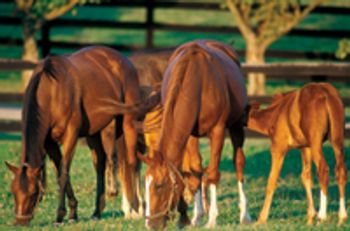
Polypharmacy is increasingly common in the prevention and treatment of diseases in animals. Drug-drug interactions represent one common event associated with multidrug therapy that may interfere with optimal clinical outcome.

Polypharmacy is increasingly common in the prevention and treatment of diseases in animals. Drug-drug interactions represent one common event associated with multidrug therapy that may interfere with optimal clinical outcome.

Opioids are commonly used in veterinary medicine for their analgesic, sedative, and anti-diarrheal properties. Opioids are also effective antitussive agents and in appropriate doses opioids can provide anxiolytic effects.

For many years, short and long-term therapy of epileptic disorders in dogs and cats has been based on the use of benzodiazepines (e.g. diazepam), barbiturates (e.g. phenobarbital) and bromide, either individually or with different combinations. While phenobarbital and bromide are still widely used for the long-term therapy of epilepsy in dogs and cats, newer agents have become available that can be used as adjunctive or sole therapy.

Acute abdomen is the acute onset of abdominal pain that requires prompt diagnosis and immediate intervention to prevent patient deterioration. The decision to operate depends on efficient diagnostic evaluation, and the timing of the surgery should be based on what will maximize survival and minimize morbidity.

Postoperative management of acute abdomen patients includes general supportive measures and monitoring commonly performed with critically ill patients, analgesic medication, nutritional support, and specific interventions based on the underlying cause of the acute abdomen and/or the surgical manipulations employed to treat the condition.

Morphine cannot be used in cats due to CNS excitement and slow metabolism and morphine causes histamine release in dogs resulting in severe hypotension and the most common adverse effects of opioids are cardiovascular and respiratory depression.

Definite personality changes and behavioral problems can be extremely challenging to the practitioner and extremely frustrating to the client. Some problems are mild and acceptable, while others are major concerns initiating euthanasia discussions. General behavioral changes are elderly patient's desire more attention, are more jealous, are more irritable, are less mentally alert, and have altered sleep cycles.

Unasyn 1.5 g vial (Generic ~$4.50) is commercially available containing ampicillin 1 g and sulbactam 0.5 g. Sulbactam is a beta lactamase inhibitor, therefore many people think of this drug as "injectable Clavamox."

The basic anatomical structures of the esophagus are the upper esophageal sphincter (UES), the body of the esophagus and the lower esophageal sphincter (LES). The entire canine esophagus is composed of two layers of striated muscle, while the distal third of the feline esophagus is composed of striated muscle.

Bovine respiratory disease complex includes bacterial components, which cause the classic clinical signs of lethargy, depression, and fever, with variable nasal discharge, cough, or other signs. This bacterial component of BRD (most commonly Mannheimia haemolytica, Pasteurella multocida, Histophilus somni, and Mycoplasma bovis) may be treated with antimicrobial drugs designed to kill or inhibit the growth of the pathogenic bacteria.

Elevations of in one or more serum liver enzyme activities (LEA) are a common finding on serum biochemical analysis. Liver enzyme measurements do not reflect liver function but rather hepatocyte membrane integrity, cholestasis and enzyme induction.

Species of poisonous snakes found in North Carolina - Pit Vipers (Copperhead (Agkistrodon contortrix), Cottonmouth (Agkistrodon piscivorous. Timber Rattlesnake (Crotalus horridus, Eastern diamondback rattlesnake (Crotalus adamanteus, Pygmy rattlesnake (Sistrurus miliarius), Elapidae Eastern coral snake (Micrurus fulvius fulvius).

The AVMA HOD votes on three resolutions concerning antimicrobial use.

Investigating the changes in composition over the last couple of decades.

A closer look at genetics is offering new insight into disease conditions.

Benign and malignant masses are commonly encountered in the oral cavities of dogs and cats.

Contributions, causes of age-related cognitive changes in dogs.

Various nutritional factors have been linked to the initiation and recurrence of the disease process.

Gainesville, Fla. - A first-of-its-kind pilot study involving Doberman pinschers that present with early stage dilated cardiomyopathy (DCM) uses adult stem cells to mend the animal's heart activity.

Signs, diagnostic testing of this painful condition that can affect any dog.

About two fatal injuries occur daily on U.S. racetracks.

Objective forage analysis methods ensure better nutritive content for horses.

Portland, Ore. - New surveillance data compiled by experts at Banfield, The Pet Hospital reveal prevalence trends for internal and external parasite infections and hammer home the need for veterinarians to remain vigilant about promoting preventive care to clients.

Jefferson City, Mo. -- A new law, supported by the Missouri Veterinary Medical Association, allows the state veterinarian to quarantine animals suspected of carrying contagious toxins.

Image Quiz: Postoperative pain in cats, Photo A

Cincinnati, Ohio -- United Pet Group has announced a recall of all unexpired lots of its Pro-Pet Adult Daily Vitamin Supplement tablets for dogs due to possible Salmonella poisoning.

Taking the BizQuiz? This is the answer to question 6 of "Are you being compensated fairly?"

Taking the BizQuiz? This is the answer to question 2 of "Are you being compensated fairly?"

Taking the BizQuiz? This is the answer to question 5 of "Are you being compensated fairly?"

Taking the BizQuiz? This is the answer to question 7 of "Are you being compensated fairly?"